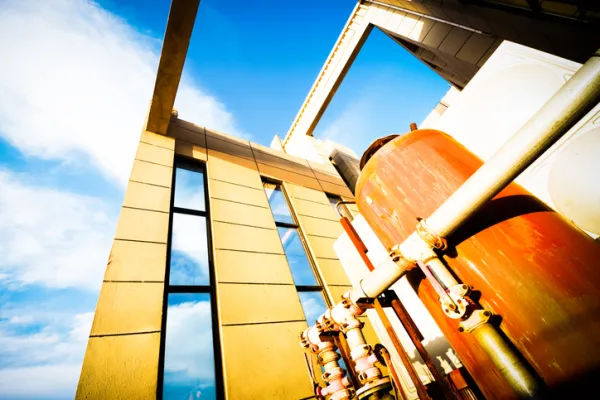A year of devastating climate change in Canada hit home for the country’s top chief executives — from drought conditions affecting the grain crop to devastating wildfires in British Columbia.
“The past year was a wake-up call to the urgent reality of climate change,” said Dave McKay, chief executive of Royal Bank of Canada, who came first in the financial institutions category of Institutional Investor’s 2022 All-Canada Executive Team.
Canada was wracked by unprecedented weather events linked to the changing climate, like a heat dome that scorched British Columbia on the west coast in June, heralding deaths and wildfires. In Labrador, on the most easterly coast, spring ice hit its lowest level in 50 years, while across the Prairies, drought withered crops. McKay wrote about these weather events as they happened, sharing his perspective on how the country must meet net-zero in op-eds in the press, and he said the transition signals a key role to play for Canada’s biggest bank. He pointed to a report from RBC Economics identifying that for Canada alone it will take $2 trillion in capital over the next three decades to achieve net-zero emissions. RBC is already on the way to meeting its goal of $500 billion in sustainable financing by 2025.
“As the transition accelerates, clients are increasingly looking to RBC for guidance on their own net zero journey – from financial and investment advice, to products and lending,” McKay said.
Keith Creel, who took top place in the capital goods and industrial category, said Canadian Pacific Railway was hit hard by the wildfires in British Columbia. “While these elements are out of our control, our team remains focused on controlling what we can control,” he said. That means customer service and good management of resources, but also innovation: Canadian Pacific Railway recently announced an extension to its pilot project to develop the industry’s first zero-emission, hydrogen-powered locomotive. “A shift away from diesel locomotives is a key component of North America’s transition to a low-carbon economy,” Creel said.
At Hudbay, the Canadian mining company primarily producing copper concentrate and zinc metal, the path to a more sustainable and energy-efficient future involves investment in technology to improve existing processes. Hudbay is deploying ore-sorting technology in Peru, allowing it to produce more metal at lower energy consumption rates while increasing output, lowering operational costs, and increasing cash flow. Meanwhile in Manitoba, where the company has been mining for more than 90 years, Hudbay is using a new copper flotation facility, which uses a first-of-its-kind circuit based on modern pneumatic flotation technology. Peter Kukielski, the top scoring chief executive in the basic materials category, said this new technology is compact, lower cost, and more flexible than previous processes.
Efficiencies like these are not just important from a climate perspective, as companies grapple with supply chain and staffing issues during the second winter of the pandemic. “The greatest challenge that will continue into 2022 is maintaining a stable workforce and maintaining the integrity of supply chains,” Kukielski told II. Copper demand is strong, he said, while new copper projects of scale are scarce. Careful management of business in this environment is paramount, especially in areas of socio-political unrest. Hudbay is one of the mining companies in Peru hit by protests that recently led the largest producer in the country to suspend operations. Kukielski cited this changing landscape as Hudbay’s biggest lesson of 2021, adding that the company engaged with ministers to gain the support of the new leftist government of Pedro Castillo for Hudbay to continue working in mining communities. “Our team in Peru has made great in-roads in terms of open dialogue at the political and community levels,” Kukielski said.
Greg Hicks at Canadian Tire Corp, who came third overall in the consumer category, said that although supply chain issues remain, they are changing over time: In 2020, it was about the supply of manufactured goods, whereas now the crisis is related to the capacity of ocean liners. Canadian Tire Corp got around these issues by chartering four of its own ships in order to meet demand before Christmas. “We’ve been making strong investments in our supply chain network and have retrofitted our distribution centers to hold more products and increase operational capacity to ensure we can keep meeting customer demand,” Hicks said.
McKay said he is cautiously optimistic about the future and expects global economic growth through the ongoing pandemic recovery in the next two years. But no one on II’s executive team is expecting the uncertainty – over the climate, the pandemic, and supply chains – to lift any time soon. “I would say that uncertainty was the defining challenge of the year,” McKay said.
Keith Creel, Canadian Pacific Railway
What has been the greatest challenge for your sector this year?
The Covid-19 pandemic continues to challenge all aspects of the supply chain, most notably in the automotive and intermodal spaces. Additionally, drought conditions this spring and summer resulted in a much smaller Canadian grain crop. The widespread and devastating wildfires in British Columbia also posed tremendous operational challenges to the industry, along with terrible impacts on local communities. While these elements are out of our control, our team remains focused on controlling what we can control. That means delivering excellent service to our customers, managing our resources in lockstep with our business, creating innovative supply chain solutions, serving the communities we operate in, and creating compelling value for our shareholders. At the same time, 2021 has also been a transformational year at CP. In September, CP signed an historic agreement to merge with Kansas City Southern to create the first Canada-U.S.-Mexico railroad. This proposed transaction will combine the two smallest Class 1 railroads, creating competition and providing shippers new single-line service options that don’t exist today. Subject to getting approval by our shareholders and the Surface Transportation Board, the combination will create capacity and options for shippers at a time the supply chain has never needed it more. Bringing these two franchises together will create value for our collective customers, employees, communities, and shareholders with public interest benefits reaching across the transportation sector.What was the biggest lesson you learned in 2021?
In a word, perseverance. Our proposed combination with Kansas City Southern was put at risk when a competitor came in with a higher bid. We knew we were better positioned to succeed and create maximum value for all stakeholders through our unique proposal. We could have walked away, but instead we chose to stand firm in our conviction that we were the only achievable path forward. In the end, after a hard-fought six months, CP and KCS got back together, and we look forward to building the first Canada-U.S.-Mexico-railroad once we have shareholder and regulatory approval.Have there been any unexpected opportunities for your business?
Certainly, the opportunity to sign a historic merger agreement with KCS required the right set of circumstances and leadership. The combination will bring together the two fastest growing railroads by revenue [over] the last three years. Additionally, the unique combination has zero network overlap, which means not a single shipper will lose options. The supply chain challenges brought on by the pandemic have proven how important supply chain capacity, fluidity, and competitive shipping options are. This, along with the recently signed USMCA trade agreement, creates a unique opportunity for the combined CPKC. We are incredibly excited about the opportunity ahead of us with this transformational transaction.What is the greatest challenge that lies ahead for 2022?
As we head into 2022, the broader supply chain still faces more challenges. CP has an opportunity to be a part of the long-term solution. We can transport large quantities of freight over long distances at a lower cost and with lower environmental impact compared to trucks. The CPKC merger, once approved, will create capacity and open competitive markets for customers across North America. It will enhance competition in the industry and attract new customers to rail that would otherwise use trucks. We want to be part of the solution to a congested and fragile supply chain.How is your company innovating?
CP innovates in many ways with a focus on safety and service. We were the first railroad in North America to receive a regulatory exemption for the use of our automated train inspection portal for loaded potash trains. Those trains now move through the terminal faster and with a higher defect detection rate than traditional manual safety inspections. We are proud of the work the team did working with regulators and we are expanding our use of the technology across additional fleets in order to expand the operational and safety benefits. CP has always been a leader and innovator in locomotive technology. Thirty-five years ago, CP introduced North America’s first alternating current traction diesel-electric locomotive. At the time, AC traction for locomotives was a major improvement over the old DC systems. That commitment to innovating continues today. We recently announced an expansion to our pilot project to develop the industry’s first zero-emission, hydrogen-powered locomotive. We are taking steps to move to a zero-emission locomotive and transforming our industry. A shift away from diesel locomotives is a key component of North America’s transition to a low-carbon economy.Greg Hicks, Canadian Tire Corp.
What has been the greatest challenge for your sector this year?
As was the case in 2020, the impact of Covid-19 presented many significant challenges for everyone. In 2021 specifically, continuing to protect the health and safety of our customers and employees has been paramount, as well as navigating supply chain disruptions to ensure products are readily available to customers. While the supply chain issues we faced in 2020 were more centered around manufacturing supply, this year’s challenges were primarily related to ocean freight capacity. Although we are not immune to these issues, we’ve proven that between our strong supply chain capabilities and experienced teams, our supply chain can stand up to even the most unprecedented of challenges. We even chartered four ships entirely dedicated to carrying our products, which enabled us to bring in key Christmas and winter categories in time for Q4.What was the biggest lesson you learned in 2021?
I’ve learned it’s critical for brands to have a clear purpose, which, for us, has been [about] being there for life in Canada. This has served as our North Star throughout the pandemic, galvanizing our teams and enabling us to stay connected — to something greater than ourselves and to each other — even when the majority of our teams remain physically apart. This fundamentally changed how we work together, and I’m very impressed with how our culture has evolved: We’re faster, more agile, and more collaborative than ever before. The crisis really put into perspective who we are and what we stand for as a company, and our teams have accomplished incredible outcomes as a result.Have there been any unexpected opportunities for your business?
This year provided us with the opportunity to forge even stronger connections with our customers. Throughout the period when a significant number of our stores were closed for in-store shopping, we remained connected to our customers through our highly competitive omnichannel offering. Customers can shop across our banners and brands when, where, and how they choose — whether that be through curbside pick up, buy-online-pick-up-in-store, ship to home, or in-store shopping when it’s safe to do so. We also furthered customer engagement through the continued growth of our Triangle Rewards loyalty program. By translating our rich, first-party data from our over 10.5 million active Triangle Rewards members into critical insights, we’re able to learn more about our customers, provide them with customized offers, and ultimately create better, more valuable customer relationships.What is the greatest challenge that lies ahead for 2022?
In 2022, the greatest challenge for us, and all retailers, will be the prolonged uncertainty related to the ongoing pandemic. We know there have been, and will continue to be, fundamental changes to how the Canadian consumer lives, works, and shops — and how we have responded has increased Canadians’ trust and confidence in our ability to fulfill those needs. We are continuing to forge our future with confidence and have much to look forward to in 2022, the year of Canadian Tire’s 100th birthday. In addition to celebrating this incredible milestone, we’re setting ambitious business goals for the future. At our 2022 Investor Day, we’ll be sharing our three-to-five-year strategy, including our strategic direction, which highlights our choices and actions to differentiate and enable growth. We will also unveil our evolved brand purpose and core values to our internal teams in the new year. With a newly articulated brand purpose and a strategic plan for growth, we will be prepared to overcome whatever challenges lie ahead.How is your company innovating?
We have been greatly expanding and innovating our eCommerce capabilities since the onset of the pandemic, investing heavily in data analytics, and ramping up website functionality to give customers the ability to shop in the way that suits their needs. We’ve been making strong investments in our supply chain network and have retrofitted our distribution centers to hold more products and increase operational capacity, to ensure we can keep meeting customer demand. We have a $5 billion, highly differentiated owned-brand business and the capabilities to design coveted, innovative products, such as our NOMA Smart Home technology and the Forward With Design lifestyle brand. We are also evolving our Triangle Rewards loyalty program with a new subscription-based loyalty tier called Triangle Select, developed for Triangle members who desire accelerated rewards, experiences, and value-driven benefits.Peter Kukielski, Hudbay Minerals
What has been the greatest challenge for your sector this year?
At Hudbay, one of our greatest challenges and priorities this year has been keeping our people safe in the wake of a pandemic, while successfully executing our strategic objectives. In Peru, we worked hard to maintain operations at our Constancia and Pampacancha sites while working to get our employees vaccinated. Today, 95 percent of our workforce in Peru is fully vaccinated. In Manitoba, strict Covid-19 provisions led to restricted availability and movement of personnel. Despite multiple barriers, we successfully completed the refurbishment of our New Britannia mill and construction of our new copper flotation facility. We have also seen supply chain challenges in the mining sector, and as demand continues to rise, we expect to see weak supply chain links related to personnel availability and inflationary cost pressures. All that said, we are fortunate at Hudbay to have a disproportionately talented team who continue to prove that people are at the core of what we do and why we do it.What was the biggest lesson you learned in 2021?
Our biggest lesson this year has been our learnings surrounding the socio-political landscape in Peru. Following the introduction of new political leadership, our team in Peru has made great in-roads in terms of open dialogue at the political and community levels. Through effective, high-level ministerial engagement, our people in Peru have been able to drive awareness of the benefit of our work with local communities. This has resulted in successful support and resources from the Peruvian government for Hudbay to continue supporting the communities in which we operate.Have there been any unexpected opportunities for your business?
We have uncovered several new opportunities this year, including the discovery of our Copper World deposits in Arizona. With the identification of seven deposits at Copper World this year, the project spans a total of seven kilometers of oxide and sulphide copper mineralization and has the potential to support an operation entirely on our wholly-owned private land package.In Manitoba, the recent refurbishment of our New Britannia mill significantly increases our processing capacity and is expected to lead to meaningful growth in our annual gold production. We also identified the opportunity to increase the daily production rate from our Lalor mine — from 4,500 tonnes to 5,300 tonnes per day — by utilizing future available equipment and personnel from our 777 mine. Looking out to the future, we are exploring the opportunity to reprocess tailings at our Flin Flon facility in Manitoba. While this opportunity is still in its early stages, further scoping and feasibility studies will follow, and if successful, it has the potential to create economic benefits for the Flin Flon community while also reducing our environmental footprint.







